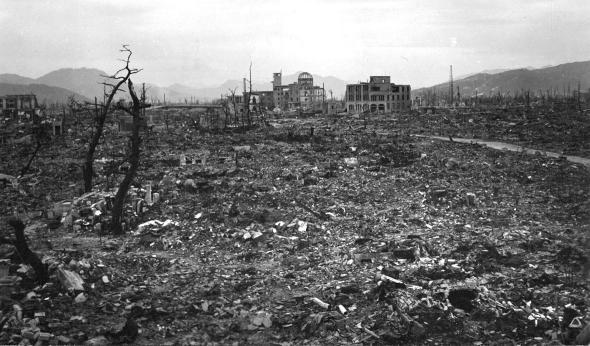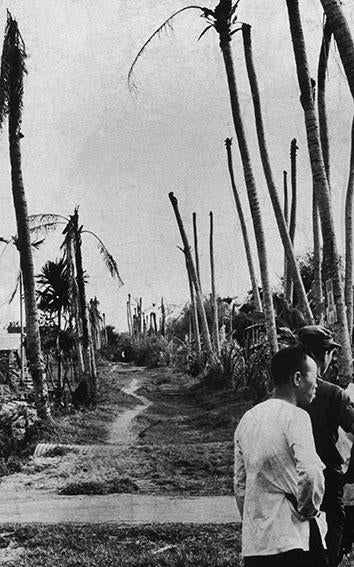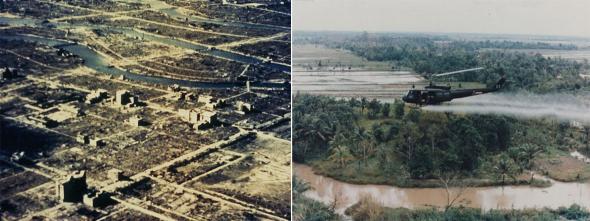This year marks two somber anniversaries: Seventy years ago, the United States became the first and only country ever to use atomic weapons in war, incinerating the cities of Hiroshima and Nagasaki in the last days of World War II. Two decades later, the massive bombing campaign of Operation Rolling Thunder and the introduction of ground troops in Vietnam ushered in an era of napalm-fueled destruction, Agent Orange defoliation, and brutal “search-and-destroy” missions. The prolonged war cost tens of thousands of American lives and displaced, maimed, and killed millions of Vietnamese.
The use of the atomic bomb and the escalation of the war in Vietnam represent two of the most controversial episodes in the history of American warfare in the 20th century. Yet we rarely think of them as connected. We should. The terror unleashed at the dawn of the atomic era established the high stakes of the Cold War and pushed American policymakers to draft the infamous ever-escalating yet non-nuclear blueprint for war in Vietnam. The bombings in Japan and the conflict in Vietnam also share a surprising set of common players: American scientists. Twenty years after their handiwork wrought destruction in Hiroshima and Nagasaki, Manhattan Project veterans found themselves ensconced in key government and military advisory positions just as the war in Vietnam reached lethal new heights. Perhaps no other group of Americans offers as poignant a portrait of the tortured path from Hiroshima to Hanoi as these men do. Twice in their lifetimes, these elite scientists willingly contributed their expertise to devastating projects whose outcomes they couldn’t control and would come to regret.
The physicists who joined the Manhattan Project in the early days of World War II were largely patriotic men who worried that Nazi scientists were racing to build an atomic bomb. They saw their work as intellectually exciting, but also necessary and just. As it became increasingly clear that the Germans had failed in their efforts, however, a handful of Manhattan Project participants began to worry about how the bomb might actually be used. In July 1945, concerned researchers at the University of Chicago’s “Met Lab,” home of the first nuclear chain reaction, sent a petition to President Harry Truman, urging him to consider the “moral responsibilities” involved in any decision to use the atomic bomb against Japan. The physicist Leo Szilard, who in 1939 had joined Albert Einstein in calling for what would become the Manhattan Project, now begged the president to avoid a direct atomic attack and instead opt for a demonstration of the bomb’s destructive power on an uninhabited island. His entreaties fell on deaf ears.
The first reports from Hiroshima and Nagasaki devastated these physicists and forced the entire cohort of Manhattan Project scientists to confront the terrifying implications of their work. Robert Wilson, a Los Alamos veteran, later recalled his sickening realization of the gap between sterile scientific calculations and the terrifying reality of atomic destruction. “It was one thing to have a scientific expectation about the damage to be caused by a nuclear bomb, and we had learned that,” he observed. “But it was another thing, just after the bombing attack, to have the actual horror described to us in more and more gruesome details. … For me the experience was an unforeseen, powerful, revelation. It was an epiphany that has changed my life.” Decades later, the agonized Wilson told a documentary filmmaker of his deep remorse at not leaving the project after the German surrender.

The destruction in Hiroshima after the US dropped an atomic bomb, 1945.
Photo courtesy National Archives
Not every Manhattan Project scientist had as visceral a reaction as Wilson, but in the aftermath of the bombings, many felt burdened with a powerful sense of moral obligation: Because physicists had invented the bomb, physicists must now work to prevent its further use. This weight even hung over scientists who had never set foot in the Met Lab or Los Alamos. From the most elite universities and from cutting-edge national laboratories, scientists joined Manhattan Project veterans such as Hans Bethe and I.I. Rabi to create the Federation of American Scientists and the Bulletin of the Atomic Scientists, organizations devoted to arms control and disarmament. They raised awareness about the risks of radioactive fallout from nuclear tests. And when the Soviet launch of the satellite Sputnik in 1957 prompted a renewed attention to American science, this cohort took on advisory roles in the White House and the Pentagon. Bethe, Rabi, and others flooded into newly created positions on the President’s Science Advisory Committee, at the Advanced Research Projects Agency, and in the Institute for Defense Analyses. With access to top decision-makers and the president himself, it seemed a golden opportunity to promote arms control from within and without government.
Unfortunately, the 1950s proved an inauspicious decade to achieve this goal. Although President Dwight Eisenhower respected his science advisers and took their advice seriously, his national security program rested on the deterring power of a massive nuclear buildup. Science advisers dutifully offered hard-nosed appraisals of existing weapons systems, but their simultaneous quest to secure a nuclear test ban foundered as tensions with the Soviet Union escalated. Painstaking research into the technology needed to enforce a test ban meant little without the political will of Eisenhower and Soviet Premier Nikita Khrushchev.
With the election of John F. Kennedy in 1960, however, arms control scientists found a powerful ally. Kennedy had touted the infamous “missile gap” on the campaign trail, but once in office he listened carefully to his science adviser, Jerome Wiesner, and his secretary of defense, Robert McNamara. They counseled him away from Eisenhower’s hawkish nuclear policy. McNamara favored a security strategy rooted in “gradual escalation” and “flexible response” rather than nuclear deterrence alone. Wiesner, an engineer who had worked on both radar and the atomic bomb during the war, embraced the new focus on limited war and frantically pressed Kennedy to endorse a nuclear test ban. The effort culminated in the compromise 1963 Limited Test Ban Treaty, which prohibited atmospheric nuclear testing, the major source of radioactive fallout.
But even as Kennedy’s science advisers celebrated their arms control success, their docket of assignments was slowly changing. As early as the 1960 presidential campaign, Wiesner had encouraged Kennedy to promote research into non-nuclear weapons “specialized … for the different areas where we might have to fight.” The cohort of presidential science advisers agreed, complaining that military leaders during the 1950s had developed “the big weapons systems required for general war to the neglect of the specialized weapons and systems needed to deal with limited war.” Top Pentagon leaders shared this critique, and from the earliest days of the Kennedy administration, money poured in to limited war research and development. But the shared interest in non-nuclear conflict was not simply a byproduct of scientists’ hopes for arms control; it was a road map to massive destruction in southeast Asia.
Scientists, of course, were not the architects of the Vietnam War. Postwar commitments to France and Japan had fueled American concerns in the region, and by the time Kennedy took office, a South Vietnamese insurgency, in collaboration with communists to the north, was mobilizing against the deeply unpopular U.S.-backed regime of Ngo Dinh Diem. To protect the shaky South Vietnamese government, Kennedy expanded the American presence on the ground, deploying the Green Berets, who were prepared for jungle counterinsurgency.
The presidential science advisers, hoping to avoid a nuclear war, had emphasized preparation for a non-nuclear conflict. Now Kennedy and McNamara gave them one. For the men ensconced at all levels of the military-industrial complex, this meant participating in Kennedy’s “Special Group” devoted to counterinsurgency; joining the president’s Committee of Principals on Chemical and Biological Weapons; and contributing to ARPA’s Project AGILE, a research and development program devoted to “remote area conflict.” In the spring of 1961, Pentagon planners called for new counterinsurgency-related technologies to be tested directly on Vietnamese terrain. “The area should be treated as a laboratory,” they wrote. Within a few months, ARPA was on the ground in South Vietnam, conducting studies of chemical defoliants sprayed on local vegetation.
At this early stage, the president’s science advisers had little to say by way of critique. They stood by their government, remaining in their posts after Kennedy’s assassination and into the next administration. In 1964, they formed the backbone of Scientists and Engineers for Johnson, arguing that the president would be a far more responsible steward of nuclear weaponry than his loose-cannon challenger, Barry Goldwater. (It was an argument Johnson made himself, in his famous “Daisy” television ad.) As Los Alamos veteran Donald Hornig acknowledged, “traditionally scientists and engineers don’t take an active role in political campaigns,” but the deep commitment to prevent nuclear war now demanded their participation. The small but growing conflict in Vietnam hardly registered as an area of concern.

Photo by Ralph Blumenthal/New York Times Co./Getty Images
But by 1965, the world had changed. Operation Rolling Thunder blanketed North Vietnam with a devastating bombing campaign. The first ground troops—soon to swell into the hundreds of thousands—arrived in-country. In the United States, a cadre of anti-war activists condemned the U.S. military support of the brutal South Vietnamese government. They were joined by critics of the recycled World War II technologies used toward this end, including napalm and Agent Orange, deployed to destroy foliage, crops, and entire villages.
The expansion of the war and its growing brutality proved a turning point for many of the elite scientists entrenched in government advisory positions. Harvard chemist George Kistiakowsky, a Manhattan Project veteran and member-at-large of the President’s Science Advisory Committee, had been an early champion of limited war. Now he urged the administration to pursue de-escalation. Put off by national security adviser McGeorge Bundy, Kistiakowsky looked for other ways to influence policy. He reached out to fellow scientists, finding comrades in a contingent of young physicists serving as part-time Pentagon advisers under the auspices of the Institute for Defense Analyses’ Jason division. In the spring of 1966, Kistiakowsky and the Jasons proposed a special summer session to search for a possible technological “solution” to the war.
The plight of Kistiakowsky and his peers in the mid-1960s offers a window into the intellectual torment of Cold War scientists grappling with the problem of hot war in Vietnam. George Rathjens, the chemist who served as a top nuclear weapons analyst for the IDA, declined Kistiakowsky’s invitation to join the summer session with particular poignancy. “[I am] an instrument for a policy with which I am very much in disagreement, but which I have damn little chance of influencing,” he wrote. “The bombing of the North just about brought me to the point of resigning … but I have stayed on arguing with myself that I have, or may have, more opportunity to influence things than if I left abruptly. But the hell of it is that I’m not sure whether this is really right or just a rationalization for doing the easy thing.” He agonized over whether he should remain in his own advisory role, let alone take on additional work. Kistiakowsky replied with empathy, noting his own “considerable misgivings” but arguing that he knew of “no obviously better alternative.” Both men clung to the belief that they could achieve reform by working within the system.
Kistiakowsky also sought and received encouragement from the Manhattan Project scientists’ old arms control ally: Secretary of Defense Robert McNamara. With McNamara’s blessing, the Jasons produced a series of reports that circulated at the top levels of the government. Alongside similar analyses by the regular members of Johnson’s science advisory committee, the Jasons attacked the bombing campaigns of Rolling Thunder as lethal and counterproductive. They proposed instead a technological means to de-escalate the war: a halt in the bombing alongside the creation of a sensor and mine-strewn “electronic barrier” between North and South Vietnam, which would curtail the flow of people and supplies and force a political solution. It was an awkward application of the idea of deterrence to a brutal ground-level guerrilla war.
The administration read and dismissed the scientists’ critiques. “I basically do not regard bombing as a matter of science,” commented President Lyndon B. Johnson in response to one report. McNamara duly promoted the plans for the barrier, but in his communication with other officials, he suggested that the technologies cited might have alternate applications and implied that they could be used without any corresponding halt in bombing.
The Jasons then watched, devastated, as the proposed barrier was only partially implemented, while the bombing continued unabated. They discussed the possibility of a politically motivated mass resignation. In January 1968, Kistiakowsky followed through, removing himself from all Vietnam-related posts and keeping only his position with the Arms Control and Disarmament Agency. Soon after, Berkeley chemist George Pimentel invited him to join in the creation of Scientists and Engineers Against Johnson.
The disillusionment and alienation of the Los Alamos generation had lasting consequences. The growing rift between science advisers and presidential and military leadership exploded during the Nixon years, with the president eventually dismantling the entire science advisory system set up in the aftermath of Sputnik. Instead of the elite and independent-minded Manhattan Project physicists, President Richard Nixon looked to a younger generation of technocrats friendly to corporate and military priorities. Outside of government, the radicalized anti-war movement seized on the contributions of scientists to the war effort, whether researchers had provided internal criticism of existing policies or conducted classified research on the refinement of defoliants, as more examples of the military-industrial complex’s awful reach. The Jasons became particularly high-profile targets. As one critic put it, the Jasons proved that it was possible to be “a moderate, well meaning, decent war criminal.”
Attacked on the right by military leadership and on the left by the anti-war movement, the Manhattan Project generation of scientists navigated a painful path in the ensuing decades. Ironically, it was scientists’ contributions to the war in Vietnam, not the development of the atomic bomb, that opened the door to the anti-science backlash of the 1970s. Never mind that napalm, chemical defoliants, and land mines had been developed decades earlier. In the service of a war perceived as just, almost any type of weapons research could be rationalized, even, apparently, the atomic bomb. But participation in a war understood as unjust—no matter how half-hearted, tormented, or well-intentioned that participation—meant moral condemnation. Twenty years after the high-water mark of the Sputnik boom, scientists found their political influence curtailed; their academic prestige challenged by activists; and, with the onset of stagflation and weak public support, even their research funding in jeopardy. Nuclear physicists surveyed in 1981 universally lamented what they saw as deeply pessimistic popular attitudes toward science; they were convinced that the war in Vietnam had created deep and widespread “suspicion” of scientists.
In the long shadow of the atomic bomb, American scientists struggled to reconcile patriotic duty with ethical self-awareness. The Manhattan Project generation learned with painful acuity the difference between expertise and political power: They contributed to, but could not control, the course of American warfare. From the current debates over the nuclear deal with Iran to the monumental effort to combat climate change, the participation of scientists in our politics is more critical than it’s ever been. But the lessons of the 20th century tell us that so too is public engagement, democratic openness, and the building of powerful political movements. Cold War scientists were right to agonize over their contributions to the terrible technologies of American warfare, and they bear some measure of responsibility for the destruction they wrought. But it was politicians who called the shots.
